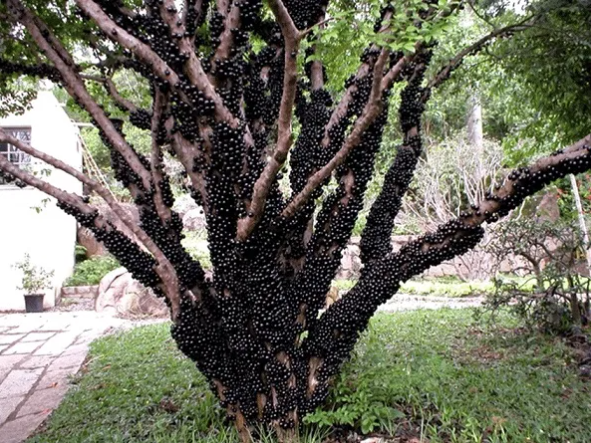
Jabuticaba is one of several trees that fruit on the trunk and branches. See below.
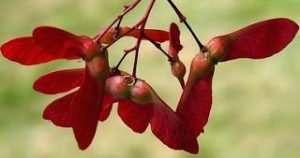
Tender Red Maple Seeds
If you look across local lakes now you will see ruby red splotches on the horizon. Those are maples putting on new leaves. Are maple leaves edible? Yes and seeds, too. Are they prime foraging food? Opinions vary. The delicate samaras (see right) happen to be red but they can also be green. Later the auto-rotating wings will turn brown. Locally the trees are so heavy with seeds they appear red from a distance. As for eating them what you need to do is taste them first. If they are not bitter you can tear off the wings and eat them raw though some folks eat the soft wings, too. If they are bitter they need to be cooked in boiling water, cooled, then tasted. They should be less bitter. You may have to boil them again. Non-bitter seeds can also be roasted or sun-dried. Some Native Americans sprouted the seeds for a treat. I do not know of any toxic maple seeds to humans but red maple (Acer rubrum) leaves and seeds are toxic to horses. That said I do recall we had two red maple intentionally planted in the barnyard. My father liked the looks of them. Our horses — definitely leaves eaters — left it alone. To read more about maples go here.
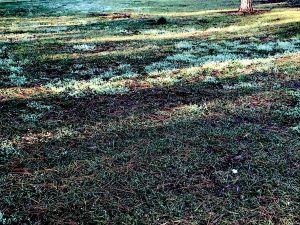
Patches of “white snow” on lawn. Photo by Green Deane
Drymaria cordata… Drymary… West Indian Chickweed… White Snow. Hopefully you can see in the accompanying picture why this species is called White Snow. When it is seeding and the sun hits the seed heads just right it can resemble a patch of white snow on your lawn. Unlike true chickweed, which is Stellaria media, Drymary is here most of the year but has similar uses to true chickweed (which you can also find right now.) Young leaves and shoots are edible, older leaves have some medicinal uses including use as a diuretic. There is some research that suggests it can reduce coughing and can easy anxiety. You can read more about Drymary here.
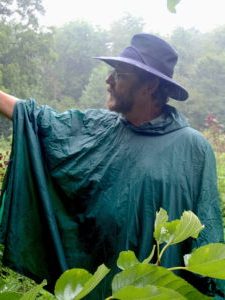
Classes are held rain or shine or cold. (Hurricanes are an exception.) Photo by Kelly Fagan.
Foraging classes: The weather should be warmer for foraging classes this weekend in Gainvesville and Winter Park.
Saturday February 6th, Boulware Springs Park, 3420 SE 15th St., Gainesville, FL 32641. 9 a.m. to noon, meet at the pavilion by the pump house.
Sunday, February 7th, Mead Gardens, 1500 S. Denning Dr., Winter Park, FL 32789. 9 a.m. to noon. The entrance is on the west side off Denning not the east side off Pennsylvania. Some GPS maps are wrong. Meet near the bathrooms.
Sunday, February 14th, Eagle Park Lake, 1800 Keene Road, Largo, FL 33771. 9 a.m. to noon. Meet at the dog park pavilion.
Sunday, February 21st, Dreher Park, 1200 Southern Blvd., West Palm Beach, 33405, 9 .a.m. to noon. Meet just north of the science center.
Sunday February 28th, Bayshore Live Oak Park, Bayshore Drive. Port Charlotte. 9 a.m. to noon, meet in the parking lot at Ganyard and Bayshore.
Saturday, March 6th, Red Bug Slough Preserve, 5200 Beneva Road, Sarasota, FL, 34233. 9 a.m. to noon.
Sunday, March 7th, Mead Gardens, 1500 S. Denning Dr., Winter Park, FL 32789. 9 a.m. to noon. The entrance is on the west side off Denning not the east side off Pennsylvania. Some GPS maps are wrong. Meet near the bathrooms.
For more information, to pre-pay or sign up, go here.
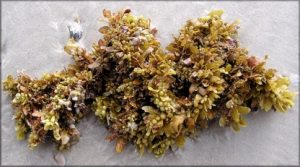
Sargassum: Edible but not the best of tastes.
This time of year it is not unusual for our beaches to be deep in aging seaweed at the high-tide mark. It’s usually almost all one species, Sargassum edible but not the tastiest of sea vegetables. It is true that nearly all seaweeds are edible if harvested from clean water. When I lived in Japan an annual environmental demonstration was to develop photographic film from unaltered water taken from Tokyo Bay. Instead of taking a few minutes, the developing took several hours but the point was made: The bay water was polluted. Generally said there are only two non-edible seaweeds in North American waters.
The first is Desmarestia ligulata. It is laced with sulfuric acid but is used to make pickles. You can find it along the northwest coast of the United States. You’ll know it when you find it because it will burn your mouth. The other in North America is a Cyanobacteria which is found in the Caribbean and linked to ciguarera poisoning. It’s not really a seaweed but is a blue-green algae found in the warmer waters. It is why one should never eat older barracuda. I should add never eat blue-green algae from fresh water either nor fish from a fresh water pond with a lot of blue-green algae. They are not on the menu. As for other parts of the world, there might be some toxic red seaweeds in the South Seas.
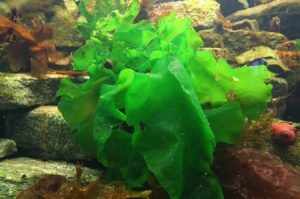
Sea Lettuce was seen in our Port Charlotte foraging class last Sunday.
Since most seaweed is edible, and nutritious, why isn’t it consumed more often? Taste and texture. I’ve collected Sargassum here in Florida and prepared it many ways. Semi-drying and frying isn’t too bad but Bladderwrack is better, Sea Lettuce better still. The latter makes very nice salads. Not surprisingly most land animals including birds don’t like seaweed. However, it does make good mulch and fertilizer. So while one may not use it directly in the diet it can still help sustain you with uses in the garden. During Victorian times it was highly used in English agriculture. Here are some of my articles on seaweed: Bladderwrack, Caulpera, Codium, Gracilaria, Sargassum, Sea Lettuce, and Tape Seagrass.

Green Deane videos are now available on a USB.
150-video USB or 135 video DVD set would be a good winter present and either is now $99. My nine-DVD set of 135 videos has been selling for seven years and are still available. They are the same videos I have on You Tube. Some people like to have a separate copy. A second option is a16-gig USB that has those 135 videos plus 15 more. While the videos can be run from the DVDs the videos on the USB have to be copied to your computer to play. They are MP4 files. The150-video USB is $99 and the 135-video DVD set is now $99. The DVDs will be sold until they run out then will be exclusively replaced by the USB. This is a change I’ve been trying to make for several years. So if you have been wanting the 135-video DVD set order it now as the price is reduced and the supply limited. Or you can order the USB. My headache is getting my WordPress Order page changed to reflect these changes. We’ve been working on it for several months. However, if you want to order now either the USB or the DVD set make a $99 “donation” using the link at the bottom of this page or here. That order form provides me with your address, the amount — $99 — tells me it is not a donation and in the note say if you want the DVD set or the USB.

Green Deane Forum
Want to identify a plant? Perhaps you’re looking for a foraging reference? You might have a UFO, an Unidentified Flowering Object, you want identified. On the Green Deane Forum we — including Green Deane and others from around the world — chat about foraging all year. And it’s not just about warm-weather plants or just North American flora. Many nations share common weeds so there’s a lot to talk. There’s also more than weeds. The reference section has information for foraging around the world. There are also articles on food preservation, and forgotten skills from making bows to fermenting food.
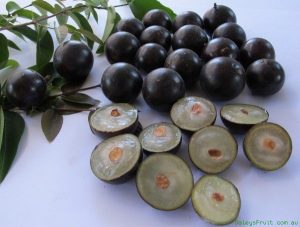
Jabuticaba fruit is high in vitamin C.
In its native Brazil the Jabuticaba is by far the most popular fruit. The Dutch knew about it in 1658. Jabuticaba made it to California by 1904. It’s a common ornamental and there are many cultivars” Sabara, Paulista, Rajada, Branca, Ponhema, Rujada, Roxa, Sao Paulo, Coroa, Murta, and Mineira. Per 100 grams Plinia cauliflora fruit has 45.7 calories, 0.11 grams of protein, 0.08 grams of fiber, 0.01 grams of fat and 12.58 gams of carbohydrates. Vitamin A is absent but it has 22.7 mg of vitamin C which is about a third of your daily need. The B vitamins are B1 (thiamin) 0.02 mg, B2 (riboflavin) 0;02 mg, and B3 (niacin) 0.21 mg. Two minerals are reported: Calcium 6.3 mg and phosphorus 9.2 mg. It is also called Myrciaria cauliflora.
It’s a short tree planted in warm areas of North American and a common ornamental in Florida and the Gulf Coast. One is reported to sustain an 18F freeze and continued to thrive and fruit. Jabuticaba means “like turtle fat” referring to the fruit pulp, or, it means “tortoise place.” Take your pick. Myrciaria is from the Greek myrike (μυρίκη) which was the Greek name for the “tamarisk” a tree that is aromatic. In English it means Myrtle. Cauliflora means cauliflower-like. Plinia is Dead Latin for filled, full, rich, whole, perfect, well-equipped. You might remember from history Pliny the Elder and Younger.
This is weekly newsletter #443. If you want to subscribe to this free newsletter you can find the sign-up form in the menu at the top of the page.
To donate to the Green Deane Newsletter click here.

